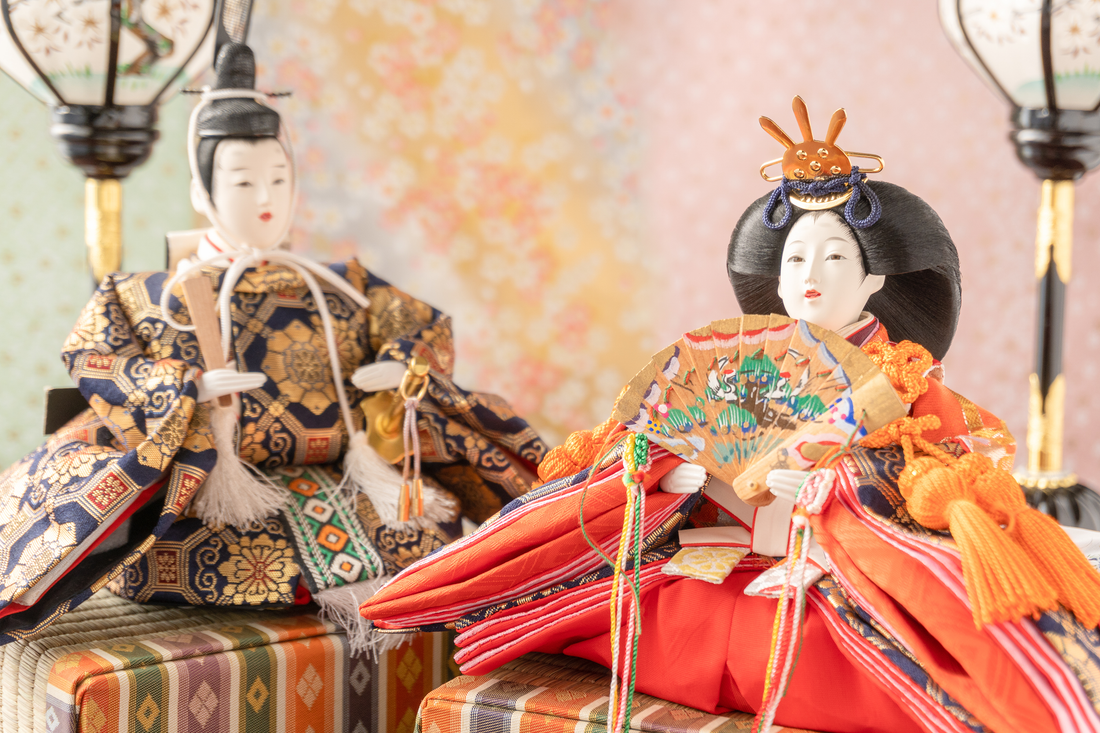Hinamatsuri (雛祭り; "Doll's Festival"), also known as or Girls' Day Doll's Day, is a religious holiday in Japan, celebrated annually on March 3rd. During this occasion, parents pray for the health, growth, and happiness of their daughters. The event is celebrated by setting up platforms that are covered with a red carpet–like material that is used to display a set of ornamental dolls representing the emperor, empress, attendants, and musicians in traditional court dress from the Heian period (794 - 118 AD).
Historical Origins
The earliest record of displaying the dolls is from 1625, for Emperor Go-Mizunoo's daughter Oki-ko, when imperial court ladies set up equipment for her to play with dolls. After Oki-ko became the Empress Meishō, Hinamatsuri legally became the name of the holiday in 1687. Doll-makers began making elaborate and intricate dolls for the festival.
The complete set of dolls and accessories is called the hinakazari (雛飾り). Over time, the hinakazari evolved to include fifteen dolls and their accessories, traditionally divided into 7 tiered platforms. As dolls became more expensive, tiers were added to the hinadan (雛壇) (display stand) so that the expensive ones could be placed out of the reach of young children.
The focal point of Hinamatsuri is the display of seated male and female dolls, the obina and the mebina, which represent a marriage from the Heian period, but are usually depicted as the emperor and empress of Japan respectively.
The dolls are typically seated on red cloth and can be as simple as pictures or folded paper dolls, or as complex as sculpted three-dimensional dolls. More elaborate exhibits will include a multi-tiered doll stand depicting ladies of the court, musicians and other assistants below the empress and emperor. The number of rows and dolls a family has depends on their budget, space, etc.

Families typically ensure that girls have a set of the two main dolls before their first Hinamatsuri. Hinamatsuri dolls are generally expensive and can be passed down through the generations as heirlooms.
The hinakazari spends most of the year in storage. Mothers and their daughters start setting up the exhibit a few days before March 3rd. Traditionally, the dolls were supposed to be put away the day after Hinamatsuri; it was believed that leaving the dolls any longer would result in a late marriage for the girl. However, today some families may leave the dolls displayed for the whole month of March.
Traditional Hina Doll Display
The placement order of the dolls varies according to family tradition and location, but the order of dolls per level is the same.
The top tier holds two dolls, known as imperial dolls. These are the obina holding a ritual baton and mebina holding a fan. The two are usually placed in front of a gold folding screen byōbu and placed beside green Japanese garden trees.
The second tier contains the three court ladies san-nin kanjo who serve sake to the obina and mebina dolls. Two of the court ladies are standing with serving utensils. The third court lady is placed in the middle, holds a small table and may be standing or kneeling.
The third tier holds five male musicians. Each holds a musical instrument except the singer, who holds a fan.
Two ministers are displayed on the fourth tier. These may be the emperor's bodyguards, or administrators. Both are sometimes equipped with bows and arrows.
The fifth tier usually holds three protectors of the Emperor and Empress. On other platforms, a variety of furniture, tools, and carriages are displayed.
Today, the holiday is still celebrated throughout Japan and known as one of the five seasonal festivals held on dates that are considered lucky in the Chinese calendar. Even some city halls and museums in Japan will display hina doll sets during the month of March. If you are curious about this celebration, these exhibits are a perfect way to learn some more about Doll’s Day and get a glimpse of Japan's rich culture.

